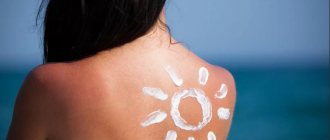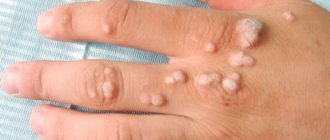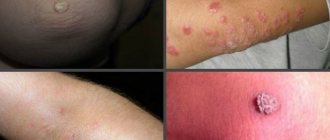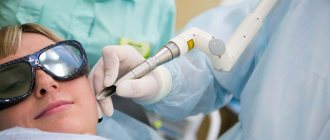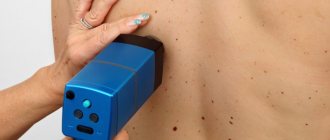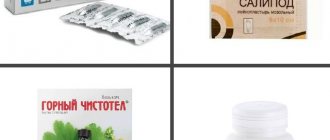What does it look like?
Warts are small, dry, flesh-colored lumps. They have a rough surface and are sometimes painful. On the hands, this can lead to a pronounced cosmetic defect.
When warts appear on the feet, severe pain appears, making it difficult to walk. Another type of wart, genital warts, develops on the genitals. This can make intimate relationships difficult. It is important to note that in women, condylomas of this localization can be caused by strains of the virus that increase the risk of cervical cancer.
Such situations require immediate treatment.
Methods for removing warts on the nose
At the moment, nasal wart removal is performed using two methods – nitrogen and a laser knife. The first option is painful, and there is a high probability of blisters after the procedure. They must not be opened or removed - they disappear on their own over time. And removing warts on the face with a laser is absolutely painless. After the procedure, a small depression may appear at the site of the wart, which disappears within a month after the procedure.
Removing flat warts on the face is a more complex procedure that will require additional research. The most important task of a specialist in this case is to determine the depth of the wart. A procedure may also be performed to remove the keratinized top portion of the wart to access the deeper layers.
What is the best way to treat?
Warts can be removed in almost any way. The surgical method, electrocoagulation, laser and cryodestruction, as well as radio wave surgery are used.
Radio wave surgery
, in my opinion, is a more effective method that allows you to remove wart tissue under visual control. When using this method, the tissue is not burned, but is excised along with a small piece of healthy skin. Thus, the likelihood of warts reappearing becomes minimal.
See all photos before and after removal
Histological examination during removal is mandatory if there is the slightest doubt.
Pharmacological method for removing warts on the face
Removal of warts on the face can also be done using pharmacological methods. But you must understand that drugs that contain a significant amount of toxic substances are used. They are the ones who destroy the wart, which will still have to be removed surgically later. Therefore, the pharmacological method is prescribed only if the wart is located in a place where it would be very difficult to reach with a laser (for example, directly in the nose).
In our clinic, the removal of warts on the nose has only the most positive reviews. You can verify this for yourself by reading them on the World Wide Web. The removal procedure will take a maximum of two visits to the attending physician, as well as about a 1-2 week recovery period. At the same time, it is not prohibited to attend work or fulfill family responsibilities. That is, there will be no postoperative discomfort in principle.
The most difficult thing from a medical point of view is removing warts on the eyelid. It is strictly forbidden to perform such procedures independently using “folk remedies”. After all, there is a significant risk of damage to the eye, which will lead to subsequent deterioration in visual function. In this case, a thorough examination by specialists will also be required, who will determine the boundaries of the compaction.
As you can see, removing warts on the head will be absolutely safe only if you seek help from a specialist. Our clinic has been performing similar procedures for many years, and the accumulated experience allows us to cope with any, even the most complex, task. It is not for nothing that we focus only on the laser method of wart removal. It is the most modern, painless and acceptable in almost any case. Moreover, it is absolutely safe. Cosmetologists also advise removing warts in this way, denying the effectiveness of others.
Symptoms of the disease
Often small polyps do not cause discomfort to patients. But, large or multiple, they can block the nasal passages, leading to breathing problems, decreased sense of smell, and recurring respiratory infections.
Most common symptoms:
- chronic runny nose;
- persistent deterioration in breathing through the nose;
- decreased or absent sense of smell;
- violation of taste sensitivity;
- facial pain, pain in other parts of the head;
- a feeling of heaviness, discomfort in the eyes, facial walls of the sinuses, head;
- snore.
How we remove warts with laser
- For two weeks, avoid solariums, sun rays, and self-tanning.
- A dermatologist examines the entire skin for the presence of all neoplasms (if there is one, there is a high probability of presence in other places).
- The doctor thoroughly cleanses the skin and prepares it for the procedure.
- Apply anesthetic for comfort (two methods: cream or injection).
- After a minute, the doctor performs the removal using a laser, having previously protected your eyes and his own with special glasses.
- After the procedure, a small wound is treated with an antiseptic, a bandage is applied to it and secured with a plaster.
Call the Telos Beauty Prof clinic by phone or
Can warts cause complications?
Warts usually do not cause complications unless they grow, become painful when walking, and cause psychological discomfort for aesthetic reasons. In rare cases, injuries can spread to adjacent areas.
Patients with a significant defect in the immune system (for example, immunodeficiency of various origins) retain the theoretical possibility of malignant formation of a simple wart, although this does not occur in everyday practice. This is in contrast to genital warts, which can also be caused by oncogenic types of human papillomavirus (HPV). Thus, to avoid the complications listed above, radical removal of warts is recommended in all cases.
Treatment of nasal polyposis
Treatment of chronic inflammation of the sinuses (with or without polyps) is a difficult task that requires complex treatment.
A team of doctors (therapist, allergist-immunologist, otolaryngologist) must participate in the treatment of the disease in order to determine an effective treatment regimen.
The goal of treatment for nasal polyposis is to reduce the size of the polyps or eliminate them. The first step begins with drug therapy. If the effectiveness of drug therapy is low, surgical treatment is resorted to. It does not provide complete recovery, but significantly improves the course of the disease. Therefore, it is necessary to continue conservative treatment in the postoperative period.
Use of medications for nasal polyposis
Treatment begins with drug therapy, which helps to reduce or disappear even large polyps.
Drug treatment usually includes:
- Nasal corticosteroids
Nasal corticosteroids have a predominantly local anti-inflammatory effect. They are used in the form of nasal sprays (with mometasone, beclomethasone) and help reduce nasal polyps.
- Systemic corticosteroids
If the administration of nasal medications is not effective, then systemic corticosteroids (dexamethasone, prednisolone, etc.) are prescribed orally or by injection. Because corticosteroids taken by mouth or by injection carry a risk of serious side effects, these drugs are not prescribed for long periods.
- Other medicines
The doctor may also prescribe other medications that affect inflammation of the mucous membrane. They may include various drugs for the treatment of allergic pathology (leukotriene receptor blockers, antihistamines, cromoglycates), antibacterial drugs for the treatment of prolonged or recurring infections.
Polyp surgery
If drug treatment does not shrink or eliminate polyps, endoscopic surgery may be required to remove them and correct sinus problems.
In the endoscopic technique, the surgeon uses a special optical tube that magnifies and displays an image of the operated area on a screen. Under visual control, the surgeon, using specialized micro-instruments, removes polyps and other obstructions from the nasal cavity and paranasal sinuses that interfere with the outflow of fluid from the sinuses.
The surgeon may also enlarge the openings connecting the sinuses to the nasal cavity.
After surgery, it is recommended to use a corticosteroid nasal spray, as well as regular rinsing with prepared saline solutions, to help prevent recurrence of nasal polyposis.
Advantages of tumor removal in Telos Beauty Prof
- Safety. Our doctor precisely affects the area of skin, clearly regulates the intensity of the beam and the depth of laser exposure. The ability to carry out the procedure on any area: face, neck, décolleté, back, arms, body.
- Quality. The high level of knowledge and extensive practice of doctors allow us to carry out procedures with minimal trauma, no complications and a short recovery period. Can be used on skin of any color.
- Comfort. The most painless analogue among other laser procedures. We use anesthesia to ensure comfort during the procedure.
- Result guarantee. A powerful effect, our doctors use their own methods of combined procedures to achieve 100% results.
- Escort. We take care of you throughout the entire period of rehabilitation, monitor and answer all questions.
- Rehabilitation. Fast recovery period, our clients undergo rehabilitation procedures with a discount of up to 50%.
- Effect. The result is noticeable immediately. Due to the correctly selected method of influence, a sustainable effect is achieved.
What are the most common warts?
Most often (up to 70% of all cases), patients report warts that bother them, and the majority of patients are school-age children. Warts are also found in 20% of students. Plantar warts are more common in adults (34% of cases), as opposed to flat warts, which are again more common in children (4% of all warts).
An experienced dermatologist can easily determine the type of wart during a consultation. However, in rare cases, especially if the wart is injured, it is difficult to diagnose it only by examination, and then the doctor can perform a biopsy of the derivative and histological examination.
Causes
Scientists do not fully understand the reasons for the appearance and growth of polyps. It is not entirely clear why ongoing inflammation triggers the development of polyposis in some people and not in others.
There is some evidence that people who develop polyps have a different immune response and distinctive mucosal chemical markers.
Conditions often associated with polyposis:
- bronchial asthma is accompanied by prolonged inflammation of all airways;
- aspirin sensitivity, intolerance to certain non-steroidal anti-inflammatory drugs causes the development of an inflammatory reaction in the mucous membrane of the respiratory tract in response to medication;
- allergic fungal sinusitis, sensitization of the nasal mucosa and paranasal sinuses to microscopic fungi and their spores;
- cystic fibrosis (cystic fibrosis), a genetic disease that leads to the formation of a very viscous secretion on the mucous membrane of the upper and lower respiratory tract;
- eosinophilic granulomatosis (Charge-Strauss), a rare pathology accompanied by inflammation of blood vessels.
Prevention
You can reduce your chances of polyps appearing or returning after treatment by following these strategies:
- Monitor allergy symptoms. Follow your doctor's recommendations to monitor the course of your allergic disease. If symptoms do not improve, consult your doctor about changing your treatment.
- Avoid irritants to the nasal mucosa. Avoid contact with substances that can cause inflammation or irritation of the mucous membranes (smoke, a suspension of small particles, caustic chemicals, allergens, dust, animal hair).
- Maintain good hygiene. Wash your hands thoroughly and regularly. This is one of the best ways to prevent infections that can cause inflammation of the mucous membranes of the nasal cavity and sinuses.
- Control the humidity in your home. When humidity levels are low, use humidifiers. This will moisturize the airways and improve self-cleaning of the sinuses and nasal cavity.
- Use nasal cleansers. Use a nasal douche (aerosol) with isotonic sodium chloride solution to clean the cavity. This will reduce the concentration of irritating agents on the nasal mucosa (allergens, dust, germs) and reduce inflammation. If you prepare your own saline solution, use distilled or boiled water.
Diagnosis of the disease
Your doctor can determine the condition based on your answers to questions about your symptoms, a physical examination, and rhinoscopy (a visual inspection of the nasal cavity using a light and a nasal speculum). But additional examination may be required to determine treatment tactics.
Additional diagnostic tests for polyposis:
- Endoscopic examination. Using an endoscope, the doctor can conduct a thorough examination of the nasal cavity.
- X-ray tomography. Images obtained by X-ray computed tomography (CT) provide information about the extent of polyposis involvement in the nasal cavity or sinuses. These tests can also help the doctor detect the presence of other abnormalities, such as a deformed nasal septum or enlarged nasal turbinates. Based on RCT images, the doctor may suspect a tumor growth other than polyposis (malignant or benign).
- Allergy detection. The doctor may prescribe an additional test to identify allergies: rhinocytogram, blood test for IgE, eosinophilic cationic protein, scarification tests. This is necessary in order to identify the presence of allergic pathology, which contributes to the development of polyposis.
- Test for cystic fibrosis (cystic fibrosis). A child diagnosed with chronic polypous sinusitis should be evaluated for cystic fibrosis. This is a hereditary disease that disrupts the secretion of glands, which leads to chronic inflammation of the respiratory tract and the development of polyposis.


